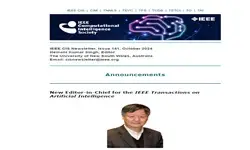-
Members: FreeCIS
IEEE Members: Free
Non-members: FreeLength: 00:54:40
08 Oct 2019
Enrique Ruspini, Palo Alto, California 94306, USA
Abstract: The ability to recognize similarities between objects, situations, and concepts is the basis of an important class of cognitive processes known as analogical reasoning. The notion of similarity and its related notion of graded preference have been shown to provide an interpretation of the basic concepts and methods of possibility theory�notably the key procedure known as generalized modus ponens. The interpretation of possibilistic constructs by Ruspini in 1991 in terms of similarity concepts led to the subsequent development of a number of approximate-reasoning methods further extending their classical logic counterparts.
The concept of similarity also plays a significant role in classification processes that seek to discover structure in data. Following the initial work of Ruspini in 1969, establishing cluster analysis as the identification of fuzzy partitions with optimal properties, a large number of methods have been developed based on the idea of mapping metrics into partitions.
In this presentation we aim to bring together our previous work on similarity-based interpretations of fuzzy logic and on relational clustering in the context of issues and methods for hierarchical clustering. Our point of departure will be the extension of similarity measures between points to one between crisp sets of the sample space through a process that is dual to that leading to the well-known Hausdorff extension of distance measures. We will present then an extension of this measure to a similarity measure between fuzzy sets of the dataset.
Having established a similarity structure between fuzzy sets we will present metric properties of curves connecting fuzzy subsets of the sample space. We will then propose a methodology, grounded on the original similarity structure, for the derivation of taxonomical trees on the basis of properties of these curves. In closing we will present applications of these ideas and discuss future research directions.
Abstract: The ability to recognize similarities between objects, situations, and concepts is the basis of an important class of cognitive processes known as analogical reasoning. The notion of similarity and its related notion of graded preference have been shown to provide an interpretation of the basic concepts and methods of possibility theory�notably the key procedure known as generalized modus ponens. The interpretation of possibilistic constructs by Ruspini in 1991 in terms of similarity concepts led to the subsequent development of a number of approximate-reasoning methods further extending their classical logic counterparts.
The concept of similarity also plays a significant role in classification processes that seek to discover structure in data. Following the initial work of Ruspini in 1969, establishing cluster analysis as the identification of fuzzy partitions with optimal properties, a large number of methods have been developed based on the idea of mapping metrics into partitions.
In this presentation we aim to bring together our previous work on similarity-based interpretations of fuzzy logic and on relational clustering in the context of issues and methods for hierarchical clustering. Our point of departure will be the extension of similarity measures between points to one between crisp sets of the sample space through a process that is dual to that leading to the well-known Hausdorff extension of distance measures. We will present then an extension of this measure to a similarity measure between fuzzy sets of the dataset.
Having established a similarity structure between fuzzy sets we will present metric properties of curves connecting fuzzy subsets of the sample space. We will then propose a methodology, grounded on the original similarity structure, for the derivation of taxonomical trees on the basis of properties of these curves. In closing we will present applications of these ideas and discuss future research directions.


